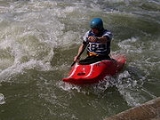
Whitewater canoeing
Encyclopedia
Whitewater canoeing is the sport of paddling a canoe
on a moving body of water, typically a whitewater
river. Whitewater canoeing can range from simple, carefree gently moving water, to demanding, dangerous whitewater. River rapid
s are graded like ski runs
according to the difficulty, danger or severity of the rapid. Whitewater grades
(or classes) range from I or 1 (the easiest) to VI or 6 (the most difficult/dangerous). Grade/Class I can be described as slightly moving water with ripples. Grade/Class VI can be described as severe or almost unrunnable whitewater, such as Niagara Falls
.
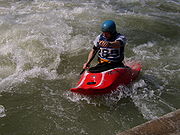
 The canoe (or just 'boat') used in casual whitewater canoeing is different from those used in whitewater racing
The canoe (or just 'boat') used in casual whitewater canoeing is different from those used in whitewater racing
. Traditionally, canoes were made of tree bark, sewn with tree roots and sealed with resin
. Early whitewater boats were made of wood followed by aluminum and later fiberglass
or kevlar
, followed by more exotic composite materials including spectra
, vectran
and carbon fiber
. The various composite materials are still preferred for racing
due to the light weight, but most modern recreational whitewater boats are typically rotomoulded
from a tough plastic
or molded from a plastic laminate called Royalex which is an ABS plastic that is slightly flexible and very durable, if easily scratched but repairable using either plastic welding or a variety of patch bonding techniques. Boats can range in size from barely long enough to hold the paddler
(around 6 ft (1.8 m) long), up to 12 ft (3.7 m) or longer for solo boats and typically 14-16ft for tandem boats.
. The raft
, the catamaran
, the canoe
and the kayak evolved depending on the needs and environment of the indigenous peoples
in different parts of the world. The modern day canoe most likely originated about 8,000 years ago.
The Greek
, Herodotus
, 484-425 BC, wrote in his travel diaries about boats with which merchandise was brought from Armenia
to Babylon
. The boats were made of a wooden framework that was covered with animal skins. Mules hauled the precious skins back to Armenia.
The Scot
, John MacGregor
published in 1866 the book A Thousand Miles in the Roy Rob Canoe. The timing was right and the book became a resounding success. With the Industrial Revolution
leading to more leisure
time in the middle of the 19th century, people in Europe
started to enjoy floating down rivers in all kinds of contraptions taking in nature previously only available to a selected few.
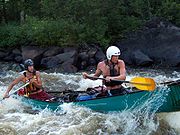 River running can be thought of as a tour down a river, to enjoy the scenery as well as experiencing challenging whitewater. River running includes short day trips as well as longer multi-day trips. Multi-day canoe trips often entail the use of gear-toting rafts to allow a more comfortable experience without a heavily-laden canoe although many people also carry their own gear in their canoes, especially on remote Canadian rivers. Canoes with gear typically are limited to class III whitewater. Sometimes, open touring canoes with gear used on multi-day trips are fitted with fabric spraycovers. Whitewater racing is the competitive aspect of this sub-category, racing canoes down a river as fast as possible.
River running can be thought of as a tour down a river, to enjoy the scenery as well as experiencing challenging whitewater. River running includes short day trips as well as longer multi-day trips. Multi-day canoe trips often entail the use of gear-toting rafts to allow a more comfortable experience without a heavily-laden canoe although many people also carry their own gear in their canoes, especially on remote Canadian rivers. Canoes with gear typically are limited to class III whitewater. Sometimes, open touring canoes with gear used on multi-day trips are fitted with fabric spraycovers. Whitewater racing is the competitive aspect of this sub-category, racing canoes down a river as fast as possible.
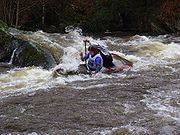 Creeking
Creeking
is perhaps best thought of as a subcategory of river running, involving very technical and difficult rapids, typically in the Grade/Class IV to VI range. While people will differ on the definition, creeking generally involves higher gradient (approaching or in excess of 100 ft per mi (19 m per km), and is likely to include running ledges, slides, and waterfalls on relatively small and tight rivers, though some will allow for very large and big volume rivers in their definition. Canoes used for creeking usually have higher volume (more gallons or liters of displacement) and more rounded bow
and stern
, as these features provide an extra margin of safety' against the likelihood of pinning, and will resurface more quickly and controllably when coming off larger drops. Creek boats usually have increased "rocker," or rise, on the bow to go up and over obstacles and obstructions within the river. Extreme racing
is a competitive form of this aspect of whitewater canoeing, in which canoers race down steep sections and or generally dangerous sections of whitewater.
 Slalom is a technical competitive form of canoeing, and the only whitewater event to appear in the Olympic Games
Slalom is a technical competitive form of canoeing, and the only whitewater event to appear in the Olympic Games
. Racers attempt to make their way from the top to the bottom of a designated section of river as fast as possible, while correctly negotiating gates (a series of double-poles suspended vertically over the river). There are usually 18-25 gates in a race which must be navigated in sequential order. Green gates must be negotiated in a downstream direction, red gates in an upstream direction. The events are typically conducted on Grade/Class II to Grade/Class IV water, but the placement of the gates, and precision necessary to paddle them fast and "clean" (without touching a pole and adding 2 seconds to the total time), makes the moves much harder than the water's difficulty suggests. (Slalom has been described as performing class V moves with class III consequences.) Pro level slalom competitions have specific length (350 cm (137.8 in) for kayaks - new rules), width, and weight requirements for the boats, which will be made out of kevlar/fiberglass/carbon fiber
composites
to be light weight and have faster hull speed. Plastic whitewater canoes can be used in citizen-level races. In the United States and Canada there are separate slalom organizations and races for decked canoes and open canoes.
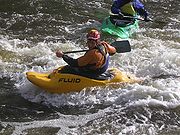 Playboating, also known as Freestyle or Rodeo, is a more gymnastic and artistic kind of canoeing. While the other varieties of canoeing generally involve going from Point A to Point B, playboaters often stay in one spot in the river (usually in a hole, pourover or on a wave) where they work with and against the dynamic forces of the river to perform a variety of maneuvers. These can include surfing, spinning, and various vertical moves (cartwheels, loops, blunts, pistol and donkey flips, and many others), spinning the boat on all possible axis of rotation. More recently, aerial moves have become accessible, where paddlers perform tricks having gained air from using the speed and bounce of the wave. Canoes used for playboating generally have relatively low volume in the bow and stern, allowing the paddler to submerge the ends of the canoe with relative ease. Competitions for playboating or freestyle are sometimes called whitewater rodeo in the US, but more frequently just referred to as freestyle events in UK
Playboating, also known as Freestyle or Rodeo, is a more gymnastic and artistic kind of canoeing. While the other varieties of canoeing generally involve going from Point A to Point B, playboaters often stay in one spot in the river (usually in a hole, pourover or on a wave) where they work with and against the dynamic forces of the river to perform a variety of maneuvers. These can include surfing, spinning, and various vertical moves (cartwheels, loops, blunts, pistol and donkey flips, and many others), spinning the boat on all possible axis of rotation. More recently, aerial moves have become accessible, where paddlers perform tricks having gained air from using the speed and bounce of the wave. Canoes used for playboating generally have relatively low volume in the bow and stern, allowing the paddler to submerge the ends of the canoe with relative ease. Competitions for playboating or freestyle are sometimes called whitewater rodeo in the US, but more frequently just referred to as freestyle events in UK
and Europe.
. This technique is used to avoid submerging the bow of the canoe by ensuring it lands flat when it hits the base of the waterfall. The term is an onomatopoeia which mimics the sound that is usually created when the hull
of the canoe makes contact with water at the base of the waterfall.
Another type of boof is the "rock boof" which is a move that uses a glancing impact with a boulder at the top of a ledge to bounce the boater over a downstream feature, often finished with a mid-air eddy turn. Rock boofs result in sounds both at the top of the drop (boat impacting rock) and the bottom (boat bellyflopping into the water).
Canoe
A canoe or Canadian canoe is a small narrow boat, typically human-powered, though it may also be powered by sails or small electric or gas motors. Canoes are usually pointed at both bow and stern and are normally open on top, but can be decked over A canoe (North American English) or Canadian...
on a moving body of water, typically a whitewater
Whitewater
Whitewater is formed in a rapid, when a river's gradient increases enough to disturb its laminar flow and create turbulence, i.e. form a bubbly, or aerated and unstable current; the frothy water appears white...
river. Whitewater canoeing can range from simple, carefree gently moving water, to demanding, dangerous whitewater. River rapid
Rapid
A rapid is a section of a river where the river bed has a relatively steep gradient causing an increase in water velocity and turbulence. A rapid is a hydrological feature between a run and a cascade. A rapid is characterised by the river becoming shallower and having some rocks exposed above the...
s are graded like ski runs
Piste
A piste is a marked ski run or path down a mountain for snow skiing, snowboarding, or other mountain sports. The term is European, from the French for trail or track, synonymous with trail, slope, or groomed run in North America....
according to the difficulty, danger or severity of the rapid. Whitewater grades
International Scale of River Difficulty
The International Scale of River Difficulty is a standardized scale used to rate the safety of a stretch of river, or a single rapid. The grade reflects the technical difficulty and skill level required associated with the section of river...
(or classes) range from I or 1 (the easiest) to VI or 6 (the most difficult/dangerous). Grade/Class I can be described as slightly moving water with ripples. Grade/Class VI can be described as severe or almost unrunnable whitewater, such as Niagara Falls
Niagara Falls
The Niagara Falls, located on the Niagara River draining Lake Erie into Lake Ontario, is the collective name for the Horseshoe Falls and the adjacent American Falls along with the comparatively small Bridal Veil Falls, which combined form the highest flow rate of any waterfalls in the world and has...
.

Design

Whitewater racing
Wildwater canoeing is a competitive discipline of canoeing in which kayaks or Canadian canoes are used to negotiate a stretch of river speedily...
. Traditionally, canoes were made of tree bark, sewn with tree roots and sealed with resin
Resin
Resin in the most specific use of the term is a hydrocarbon secretion of many plants, particularly coniferous trees. Resins are valued for their chemical properties and associated uses, such as the production of varnishes, adhesives, and food glazing agents; as an important source of raw materials...
. Early whitewater boats were made of wood followed by aluminum and later fiberglass
Fiberglass
Glass fiber is a material consisting of numerous extremely fine fibers of glass.Glassmakers throughout history have experimented with glass fibers, but mass manufacture of glass fiber was only made possible with the invention of finer machine tooling...
or kevlar
Kevlar
Kevlar is the registered trademark for a para-aramid synthetic fiber, related to other aramids such as Nomex and Technora. Developed at DuPont in 1965, this high strength material was first commercially used in the early 1970s as a replacement for steel in racing tires...
, followed by more exotic composite materials including spectra
Spectra
Spectra are conditions or values that vary over a continuum.Spectra may also refer to:* Kia Spectra, a car developed by Kia Motors from 2000-present* Optare Spectra, a bus body built by Optare...
, vectran
Vectran
Vectran is a manufactured fibre, spun from a liquid crystal polymer created by Celanese Acetate LLC and now manufactured by Kuraray Co., Ltd. Chemically it is an aromatic polyester produced by the polycondensation of 4-hydroxybenzoic acid and 6-hydroxynaphthalene-2-carboxylic acid.- Properties...
and carbon fiber
Carbon fiber
Carbon fiber, alternatively graphite fiber, carbon graphite or CF, is a material consisting of fibers about 5–10 μm in diameter and composed mostly of carbon atoms. The carbon atoms are bonded together in crystals that are more or less aligned parallel to the long axis of the fiber...
. The various composite materials are still preferred for racing
Canoe racing
This article discusses canoe sprint and canoe marathon, competitive forms of canoeing and kayaking on more or less flat water. Both sports are governed by the International Canoe Federation ....
due to the light weight, but most modern recreational whitewater boats are typically rotomoulded
Rotational molding
Rotational molding, also known as rotomolding, rotocasting or spin casting, is a molding process for creating many kinds of mostly hollow items, typically of plastic....
from a tough plastic
Plastic
A plastic material is any of a wide range of synthetic or semi-synthetic organic solids used in the manufacture of industrial products. Plastics are typically polymers of high molecular mass, and may contain other substances to improve performance and/or reduce production costs...
or molded from a plastic laminate called Royalex which is an ABS plastic that is slightly flexible and very durable, if easily scratched but repairable using either plastic welding or a variety of patch bonding techniques. Boats can range in size from barely long enough to hold the paddler
Canoeing
Canoeing is an outdoor activity that involves a special kind of canoe.Open canoes may be 'poled' , sailed, 'lined and tracked' or even 'gunnel-bobbed'....
(around 6 ft (1.8 m) long), up to 12 ft (3.7 m) or longer for solo boats and typically 14-16ft for tandem boats.
History
Paddling on rivers, lakes and oceans is as old as the Stone AgeStone Age
The Stone Age is a broad prehistoric period, lasting about 2.5 million years , during which humans and their predecessor species in the genus Homo, as well as the earlier partly contemporary genera Australopithecus and Paranthropus, widely used exclusively stone as their hard material in the...
. The raft
Raft
A raft is any flat structure for support or transportation over water. It is the most basic of boat design, characterized by the absence of a hull...
, the catamaran
Catamaran
A catamaran is a type of multihulled boat or ship consisting of two hulls, or vakas, joined by some structure, the most basic being a frame, formed of akas...
, the canoe
Canoe
A canoe or Canadian canoe is a small narrow boat, typically human-powered, though it may also be powered by sails or small electric or gas motors. Canoes are usually pointed at both bow and stern and are normally open on top, but can be decked over A canoe (North American English) or Canadian...
and the kayak evolved depending on the needs and environment of the indigenous peoples
Indigenous peoples
Indigenous peoples are ethnic groups that are defined as indigenous according to one of the various definitions of the term, there is no universally accepted definition but most of which carry connotations of being the "original inhabitants" of a territory....
in different parts of the world. The modern day canoe most likely originated about 8,000 years ago.
The Greek
Greeks
The Greeks, also known as the Hellenes , are a nation and ethnic group native to Greece, Cyprus and neighboring regions. They also form a significant diaspora, with Greek communities established around the world....
, Herodotus
Herodotus
Herodotus was an ancient Greek historian who was born in Halicarnassus, Caria and lived in the 5th century BC . He has been called the "Father of History", and was the first historian known to collect his materials systematically, test their accuracy to a certain extent and arrange them in a...
, 484-425 BC, wrote in his travel diaries about boats with which merchandise was brought from Armenia
Armenia
Armenia , officially the Republic of Armenia , is a landlocked mountainous country in the Caucasus region of Eurasia...
to Babylon
Babylon
Babylon was an Akkadian city-state of ancient Mesopotamia, the remains of which are found in present-day Al Hillah, Babil Province, Iraq, about 85 kilometers south of Baghdad...
. The boats were made of a wooden framework that was covered with animal skins. Mules hauled the precious skins back to Armenia.
The Scot
Scottish people
The Scottish people , or Scots, are a nation and ethnic group native to Scotland. Historically they emerged from an amalgamation of the Picts and Gaels, incorporating neighbouring Britons to the south as well as invading Germanic peoples such as the Anglo-Saxons and the Norse.In modern use,...
, John MacGregor
John MacGregor (sportsman)
John MacGregor , nicknamed Rob Roy after a renowned relative, was a Scottish explorer, travel writer and philanthropist. He is generally credited with the development of the first sailing canoes and with popularising canoeing as a middle class sport in Europe and the United States...
published in 1866 the book A Thousand Miles in the Roy Rob Canoe. The timing was right and the book became a resounding success. With the Industrial Revolution
Industrial Revolution
The Industrial Revolution was a period from the 18th to the 19th century where major changes in agriculture, manufacturing, mining, transportation, and technology had a profound effect on the social, economic and cultural conditions of the times...
leading to more leisure
Leisure
Leisure, or free time, is time spent away from business, work, and domestic chores. It is also the periods of time before or after necessary activities such as eating, sleeping and, where it is compulsory, education....
time in the middle of the 19th century, people in Europe
Europe
Europe is, by convention, one of the world's seven continents. Comprising the westernmost peninsula of Eurasia, Europe is generally 'divided' from Asia to its east by the watershed divides of the Ural and Caucasus Mountains, the Ural River, the Caspian and Black Seas, and the waterways connecting...
started to enjoy floating down rivers in all kinds of contraptions taking in nature previously only available to a selected few.
River running

Creeking

Creeking
-Creeking:Creeking refers to a branch of canoeing and kayaking that involves descending very steep low-volume whitewater. It is usually performed in specialized canoes and kayaks specifically designed to withstand the extreme whitewater environment in which the activity occurs...
is perhaps best thought of as a subcategory of river running, involving very technical and difficult rapids, typically in the Grade/Class IV to VI range. While people will differ on the definition, creeking generally involves higher gradient (approaching or in excess of 100 ft per mi (19 m per km), and is likely to include running ledges, slides, and waterfalls on relatively small and tight rivers, though some will allow for very large and big volume rivers in their definition. Canoes used for creeking usually have higher volume (more gallons or liters of displacement) and more rounded bow
Bow (ship)
The bow is a nautical term that refers to the forward part of the hull of a ship or boat, the point that is most forward when the vessel is underway. Both of the adjectives fore and forward mean towards the bow...
and stern
Stern
The stern is the rear or aft-most part of a ship or boat, technically defined as the area built up over the sternpost, extending upwards from the counter rail to the taffrail. The stern lies opposite of the bow, the foremost part of a ship. Originally, the term only referred to the aft port section...
, as these features provide an extra margin of safety' against the likelihood of pinning, and will resurface more quickly and controllably when coming off larger drops. Creek boats usually have increased "rocker," or rise, on the bow to go up and over obstacles and obstructions within the river. Extreme racing
Extreme racing
Extreme racing involves paddling a kayak down a section of hard whitewater requiring excellent boat handling skills. The rivers are typically class V and involve waterfalls and dangerous rapids. Races may involve mass-starts or individual timed runs....
is a competitive form of this aspect of whitewater canoeing, in which canoers race down steep sections and or generally dangerous sections of whitewater.
Slalom

Olympic Games
The Olympic Games is a major international event featuring summer and winter sports, in which thousands of athletes participate in a variety of competitions. The Olympic Games have come to be regarded as the world’s foremost sports competition where more than 200 nations participate...
. Racers attempt to make their way from the top to the bottom of a designated section of river as fast as possible, while correctly negotiating gates (a series of double-poles suspended vertically over the river). There are usually 18-25 gates in a race which must be navigated in sequential order. Green gates must be negotiated in a downstream direction, red gates in an upstream direction. The events are typically conducted on Grade/Class II to Grade/Class IV water, but the placement of the gates, and precision necessary to paddle them fast and "clean" (without touching a pole and adding 2 seconds to the total time), makes the moves much harder than the water's difficulty suggests. (Slalom has been described as performing class V moves with class III consequences.) Pro level slalom competitions have specific length (350 cm (137.8 in) for kayaks - new rules), width, and weight requirements for the boats, which will be made out of kevlar/fiberglass/carbon fiber
Carbon fiber
Carbon fiber, alternatively graphite fiber, carbon graphite or CF, is a material consisting of fibers about 5–10 μm in diameter and composed mostly of carbon atoms. The carbon atoms are bonded together in crystals that are more or less aligned parallel to the long axis of the fiber...
composites
Composite material
Composite materials, often shortened to composites or called composition materials, are engineered or naturally occurring materials made from two or more constituent materials with significantly different physical or chemical properties which remain separate and distinct at the macroscopic or...
to be light weight and have faster hull speed. Plastic whitewater canoes can be used in citizen-level races. In the United States and Canada there are separate slalom organizations and races for decked canoes and open canoes.
Playboating

United Kingdom
The United Kingdom of Great Britain and Northern IrelandIn the United Kingdom and Dependencies, other languages have been officially recognised as legitimate autochthonous languages under the European Charter for Regional or Minority Languages...
and Europe.
Boofing
Boofing, in whitewater canoeing, refers to the raising of the canoe's bow during freefall, while descending a ledge, ducking behind a boulder, or running a waterfallWaterfall
A waterfall is a place where flowing water rapidly drops in elevation as it flows over a steep region or a cliff.-Formation:Waterfalls are commonly formed when a river is young. At these times the channel is often narrow and deep. When the river courses over resistant bedrock, erosion happens...
. This technique is used to avoid submerging the bow of the canoe by ensuring it lands flat when it hits the base of the waterfall. The term is an onomatopoeia which mimics the sound that is usually created when the hull
Hull (watercraft)
A hull is the watertight body of a ship or boat. Above the hull is the superstructure and/or deckhouse, where present. The line where the hull meets the water surface is called the waterline.The structure of the hull varies depending on the vessel type...
of the canoe makes contact with water at the base of the waterfall.
Another type of boof is the "rock boof" which is a move that uses a glancing impact with a boulder at the top of a ledge to bounce the boater over a downstream feature, often finished with a mid-air eddy turn. Rock boofs result in sounds both at the top of the drop (boat impacting rock) and the bottom (boat bellyflopping into the water).
See also
- Whitewater kayakingWhitewater kayakingWhitewater kayaking is the sport of paddling a kayak on a moving body of water, typically a whitewater river. Whitewater kayaking can range from simple, carefree gently moving water, to demanding, dangerous whitewater. River rapids are graded like ski runs according to the difficulty, danger or...
- RaftingRaftingRafting or white water rafting is a challenging recreational outdoor activity using an inflatable raft to navigate a river or other bodies of water. This is usually done on white water or different degrees of rough water, in order to thrill and excite the raft passengers. The development of this...
- RiverboardingRiverboardingRiverboarding is a boardsport in which the participant lies prone on their board with fins on their feet for propulsion and steering. This sport is also known as hydrospeed in Europe and as riverboarding or white-water sledging in New Zealand, depending on the type of board used...
- River surfingRiver surfingRiver surfing is the sport of surfing either standing waves or tidal bores in rivers. Claims for its origins include a 1955 ride of 1.5 miles along the tidal bore of the River Severn...
- FreeboatingFreeboatingFreeboating is a branch of whitewater kayaking that combines playboating and creeking. Freeboating tricks usually originate in holes/waves and then are adapted to rapids and waterfalls. An example of a freeboating trick is the Hail Mary...
- List of whitewater rivers
- Canoeing at the Summer OlympicsCanoeing at the Summer OlympicsCanoeing and kayaking has been featured as a competition sport in the Summer Olympic Games since the 1936 Games in Berlin although it was a demonstration sport at the 1924 Games in Paris. There are two disciplines of canoeing in Olympic competition: slalom and sprint.Two styles of boats are...

